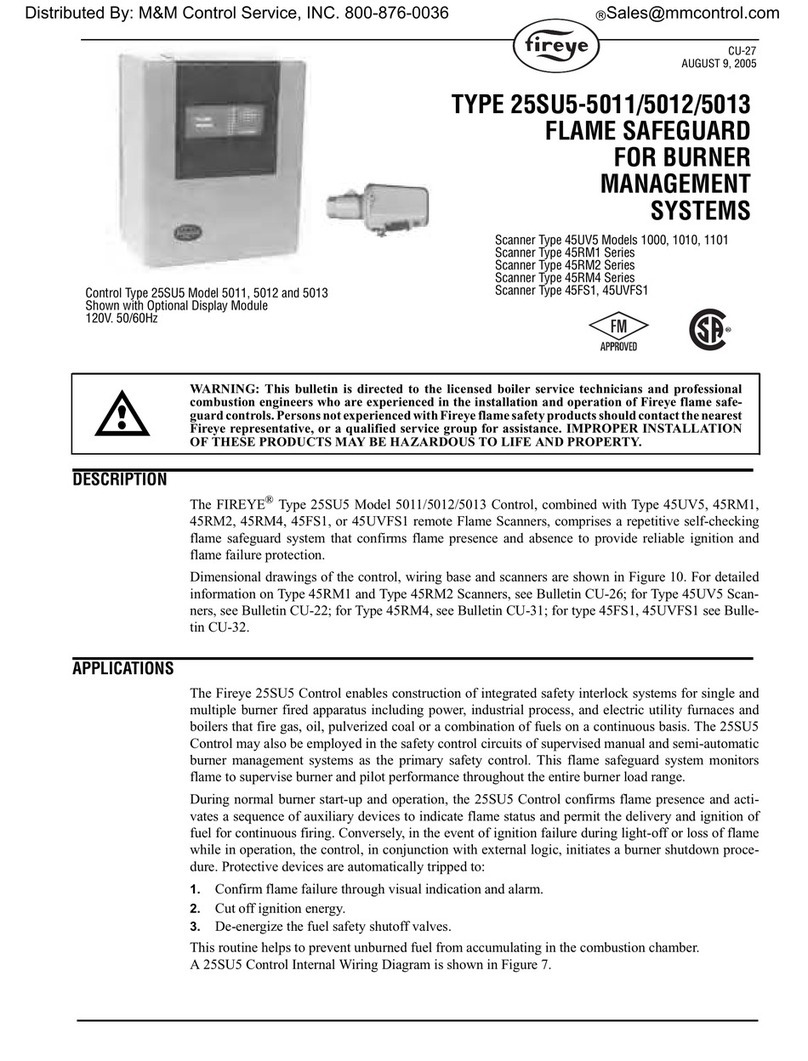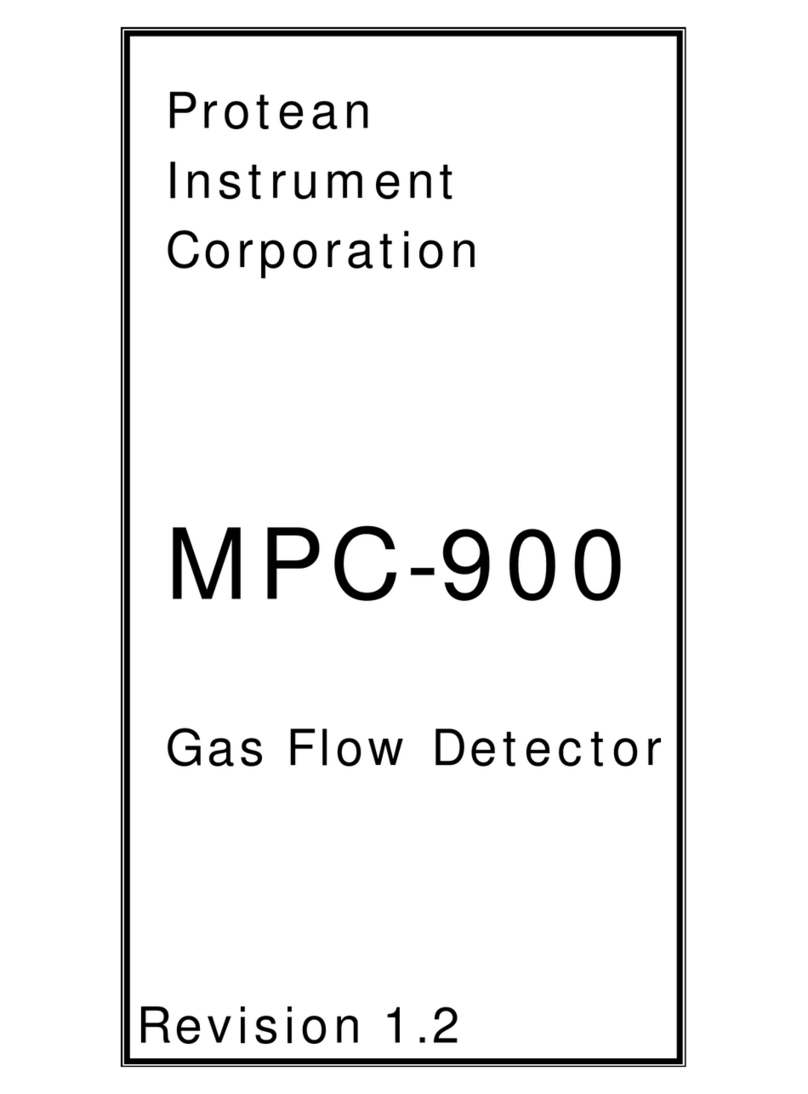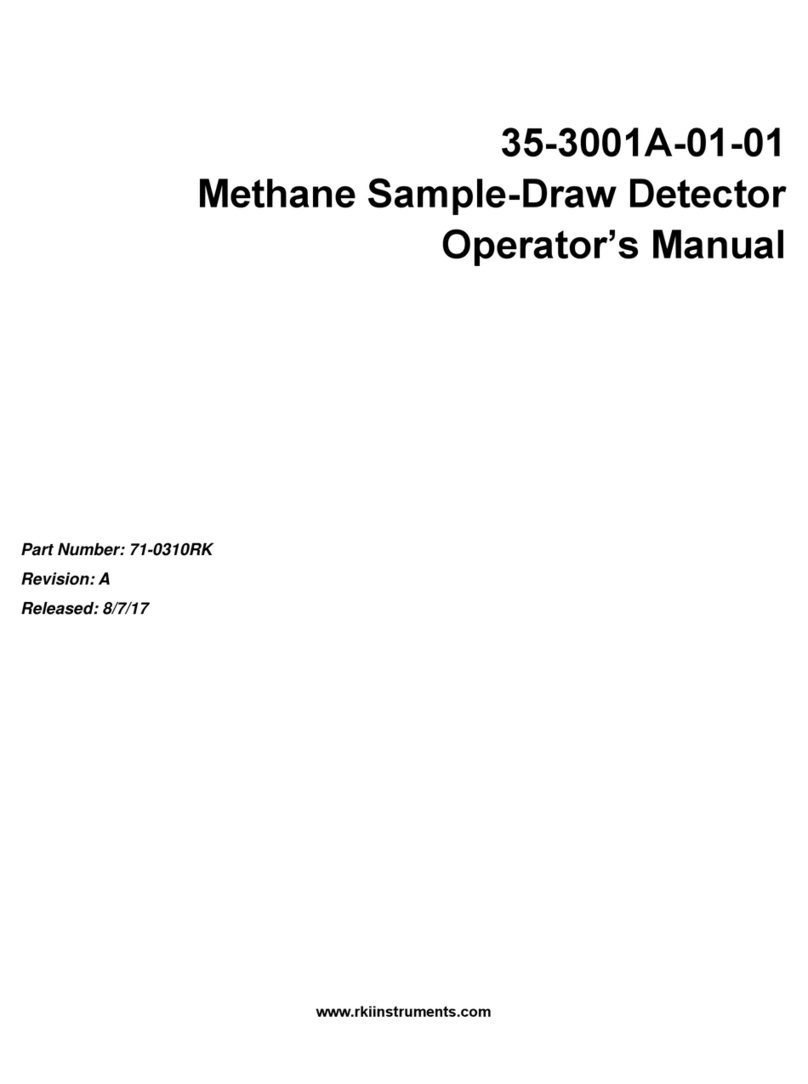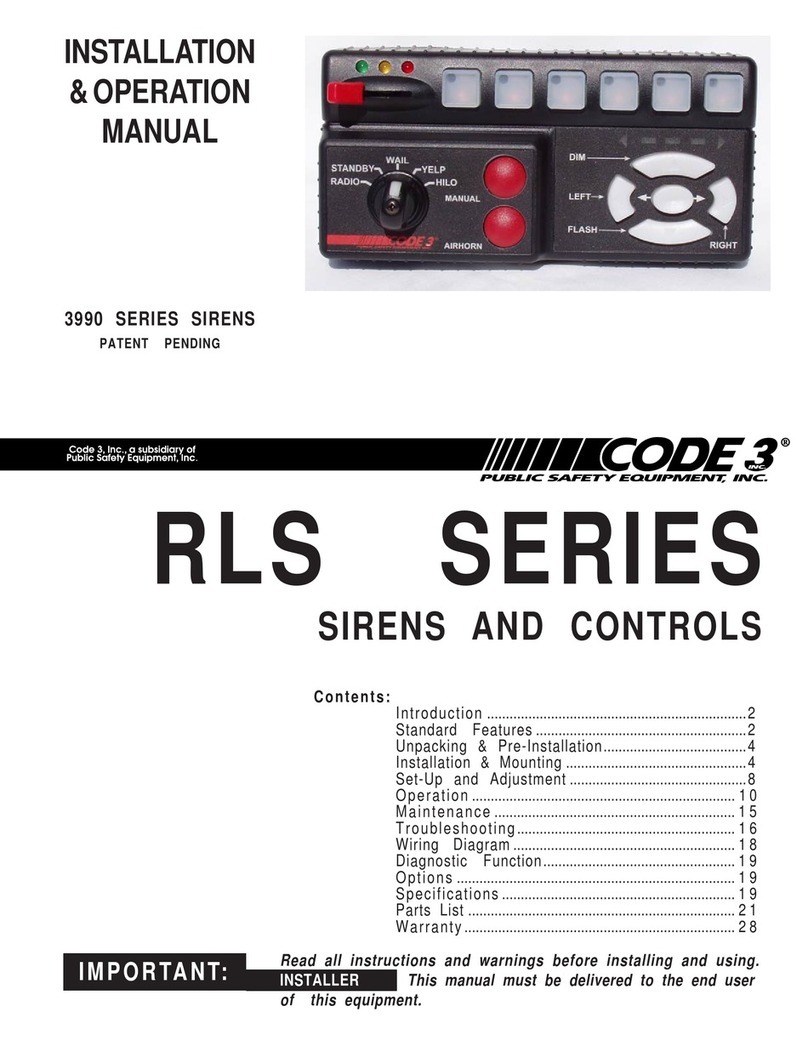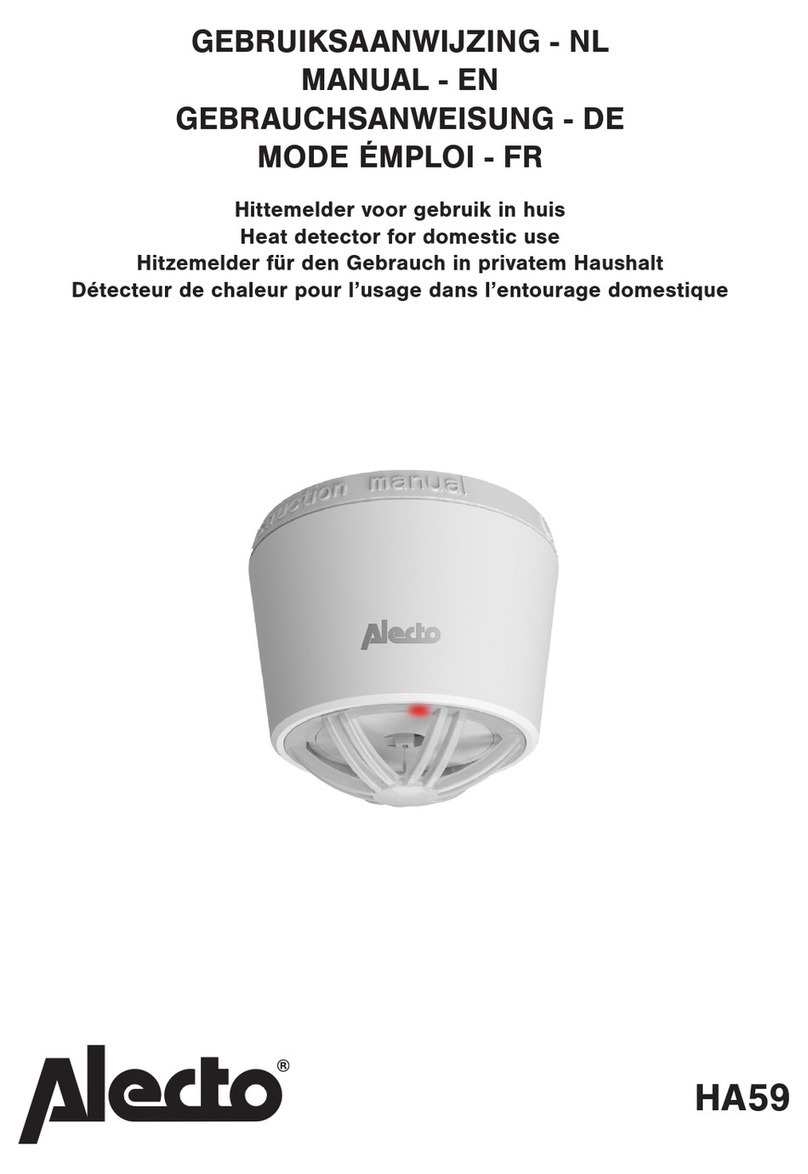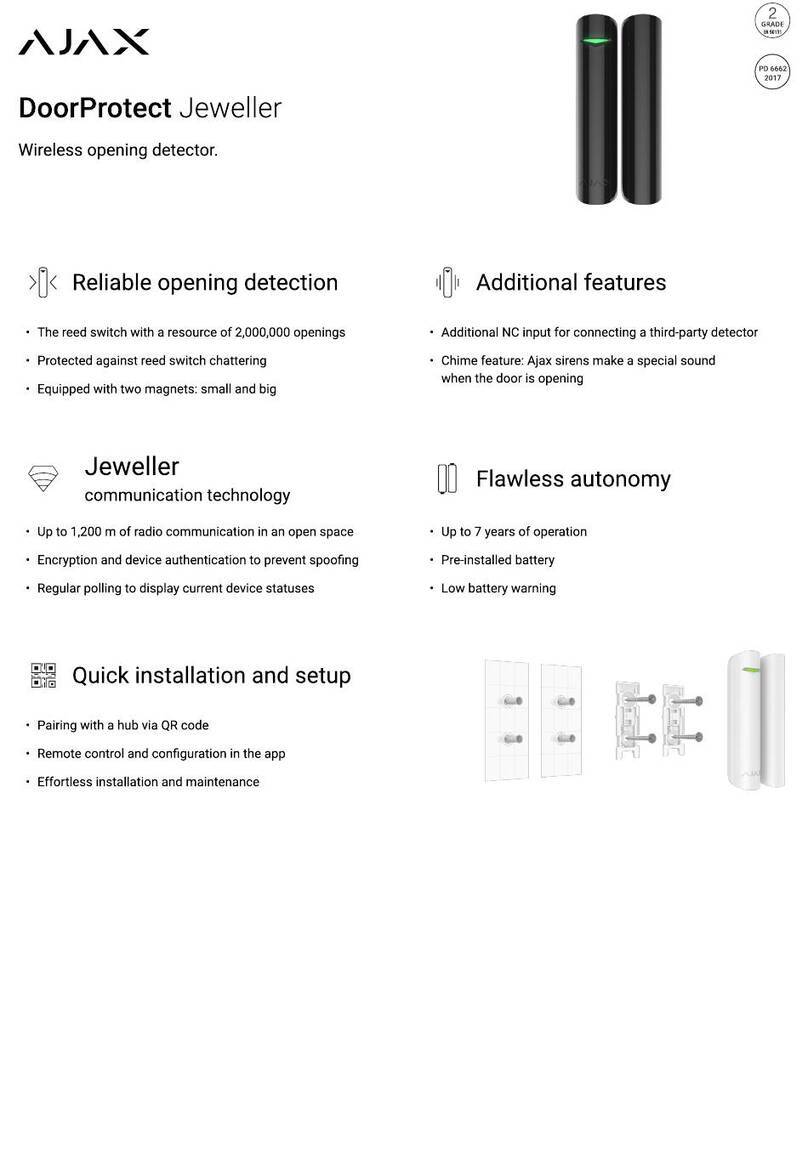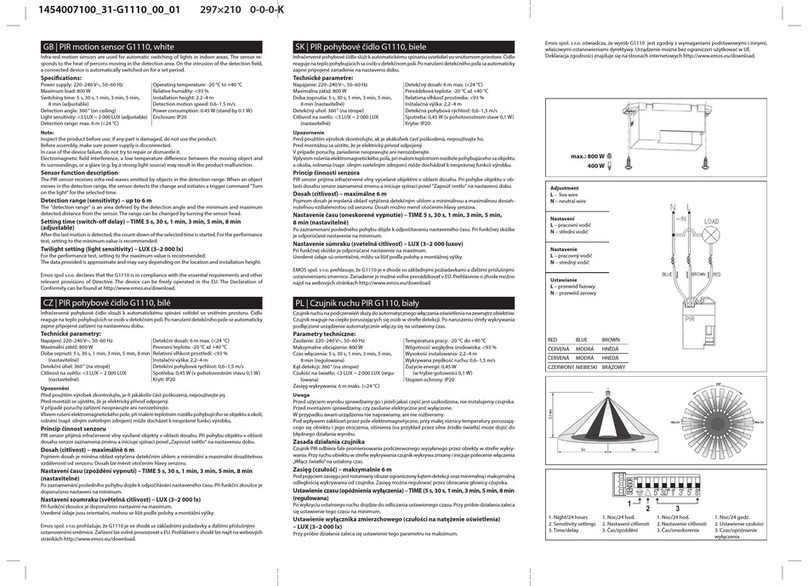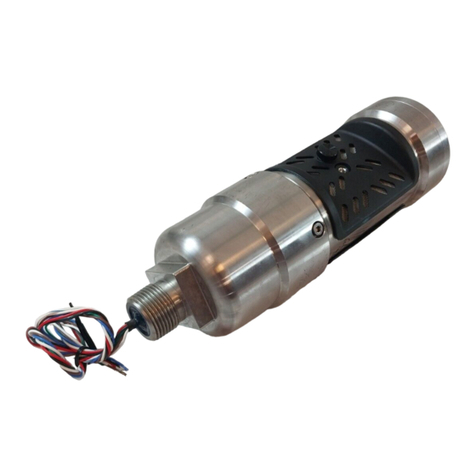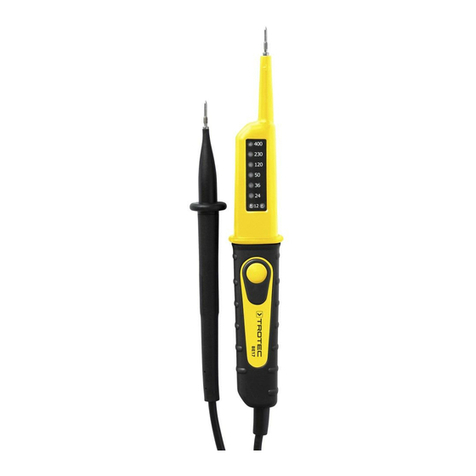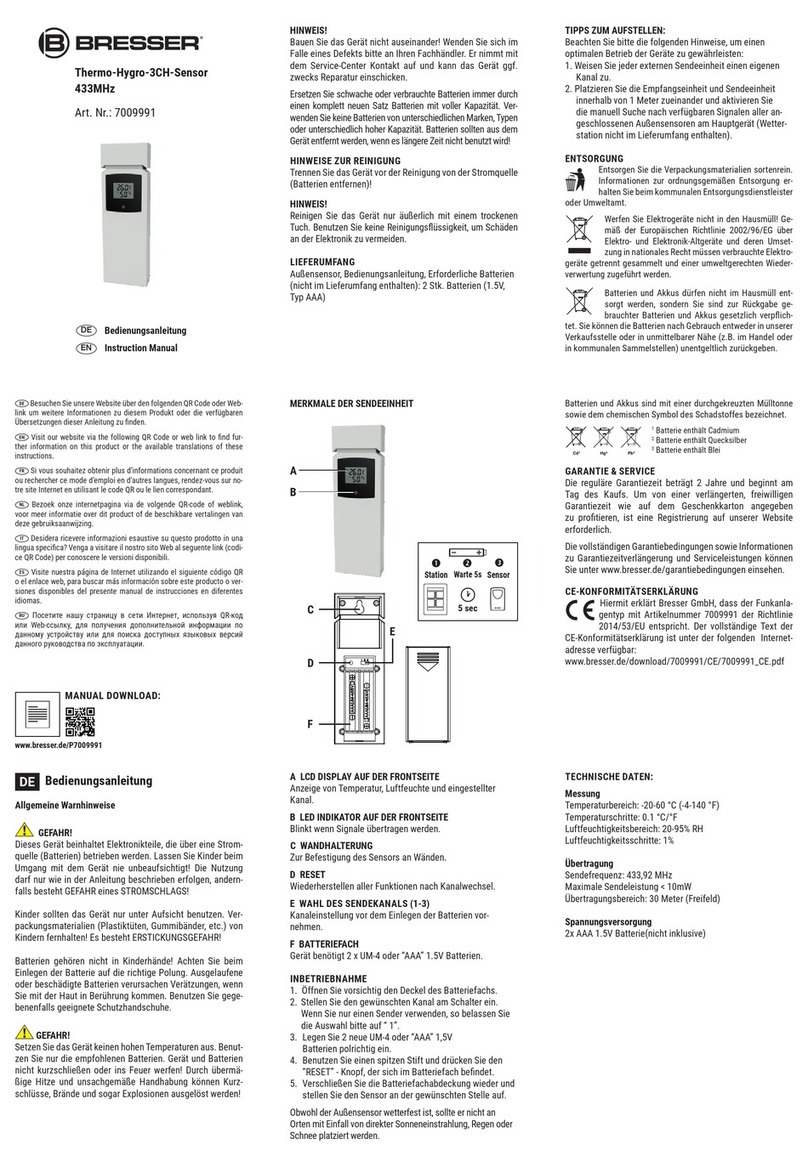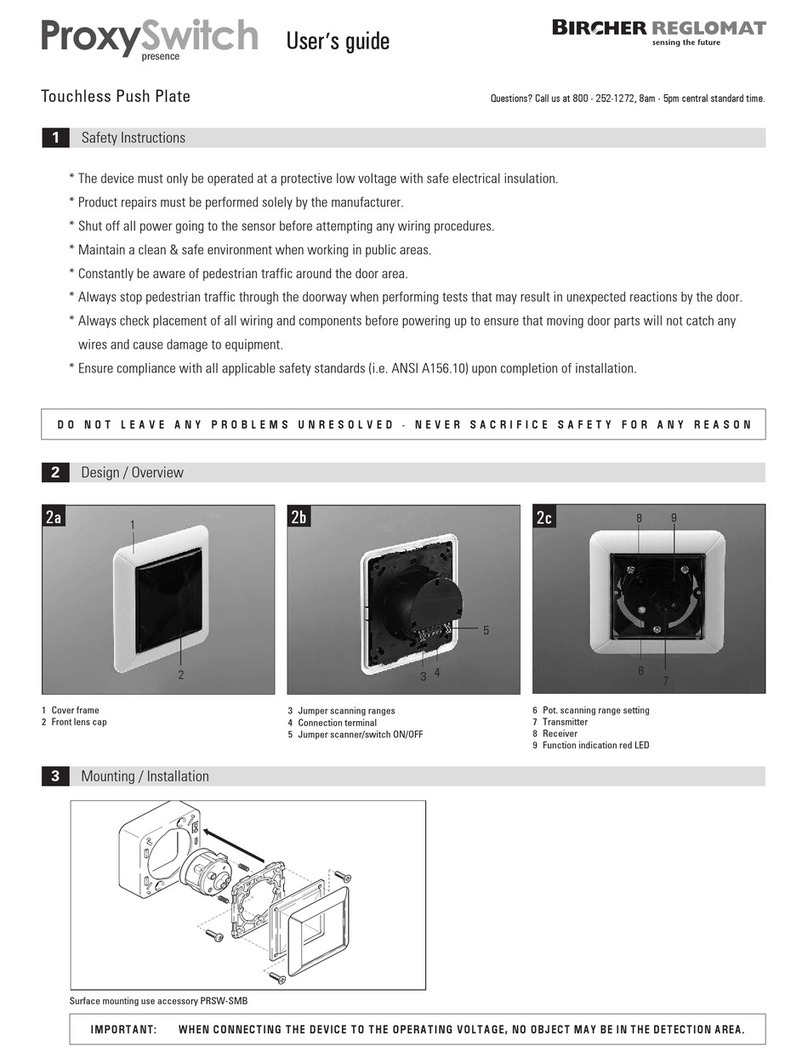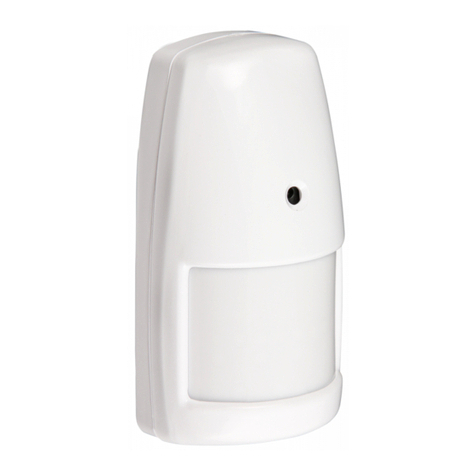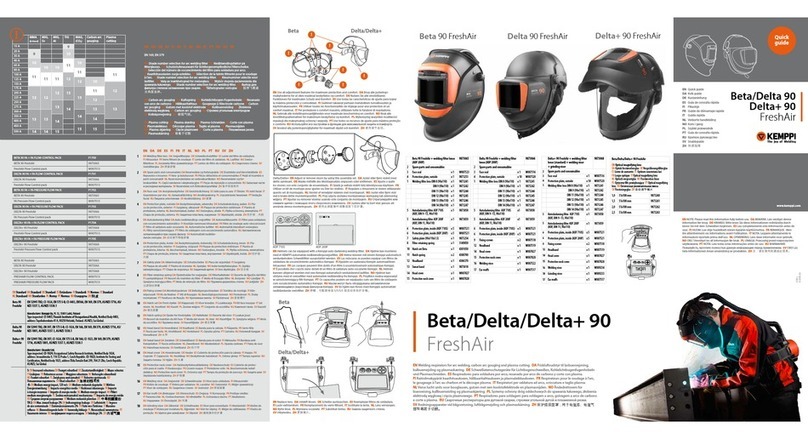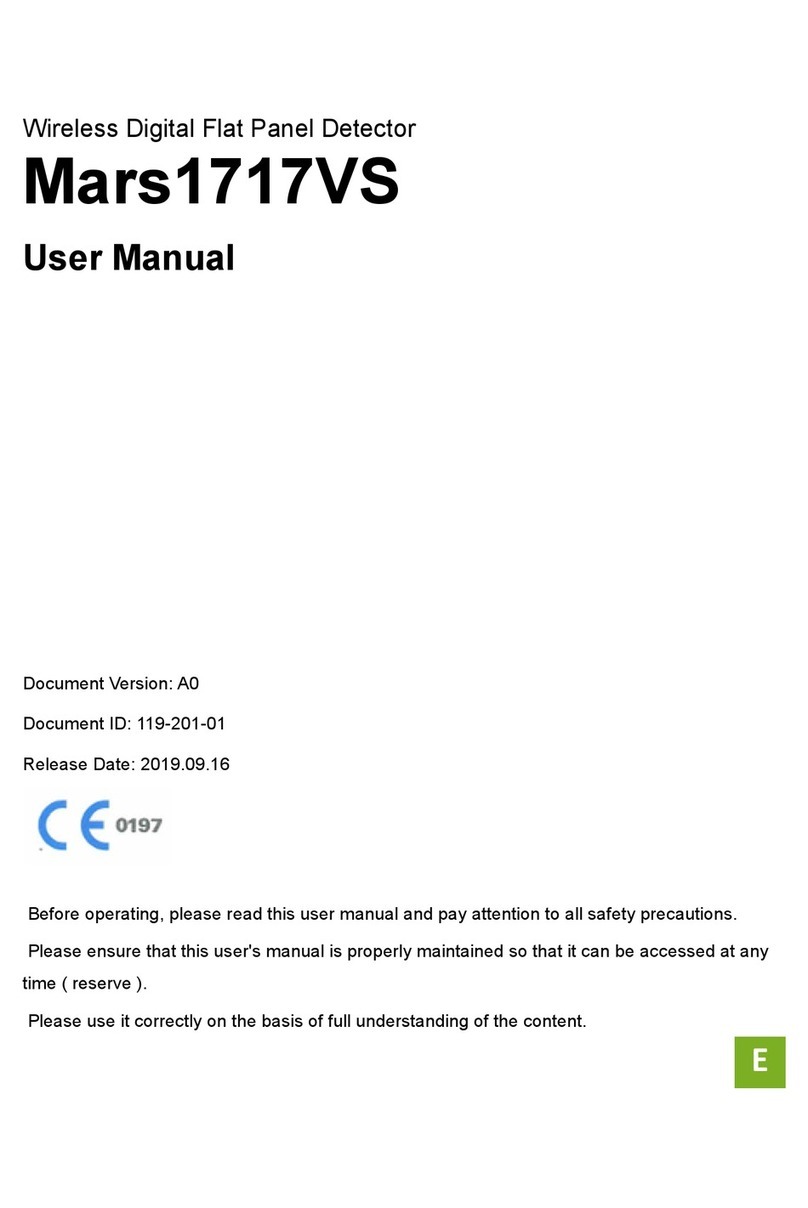Fireye FLAME SIGNATURE SCANNER 1000 User manual

1
TYPE 45FS1/45UVFS1
MODEL 1000, 1001
FLAME
SIGNATURE
SCANNER™
DESCRIPTION
The FIREYE®Type 45FS1 and 45UVFS1 Signature Scanner™ flame detectors incorporate an inno-
vative flame detection method to determine the presence or absence of a target flame in a single or
multiple burner environment. Both scanners utilize a software algorithm that constantly compares
the amplitude-frequency characteristics of the target flame with the amplitude-frequency characteris-
tics that they learn during a setup procedure. This amplitude-frequency characteristic will be referred
to as the signature of the target flame. During the learn mode the scanner performs “real time” anal-
ysis of the frequency spectrum of the AC signal of the target flame to determine the type of flame
being sensed (e.g. burner flame-on, flame tips from adjacent burners, background flame, no flames,
etc.) and determines a specific shape or Flame Signature of the flame’s frequency spectrum. When
the scanner is put in the run mode, the Signature Scanner controls constantly compare the targeted
flame signal with the learned signatures to determine the status of the flame.
The 45FS1/45UVFS1 then provides a pulsed output to indicate that the flame signal matches its
learned flame signature. This pulse output is analogous to the strength of the flame signal, allowing
the scanner to be compatible with the 25SU3 and 25SU5 style flame amplifiers.
The main difference between the 45FS1 and 45UVFS1 scanners is the flame detector utilized in each
scanner. The 45FS1 scanner incorporates a large area lead sulfide cell sensitive to the infra-red range
more suitable for coal and/or oil type flames. This cell can detect a wide range of background bright-
ness without experiencing cell washout. The 45UVFS1 scanner uses a super-blue silicon cell sensi-
tive to the UV range, as well as an automatic signal amplification circuitry making it applicable for
all fuel types (gas/oil/coal).
The Signature Scanner flame detectors have the ability for remote communication to review and
program the system setpoints as well as download and upload the “learned” flame signature data
from one scanner to another using an IBM compatible PC and the FS700 software program. Refer to
Bulletin CU-39 for details.
The 45FS1/45UVFS1 Scanners have an eight (8) character LED display, a three (3) pushbutton key-
pad, and a program enable pushbutton to program and/or review the various system setpoints and
operating parameters associated with the setup procedure and operation of the scanner. Flame signa-
tures can be learned for a number of fuel types (gas, oil, coal, etc.). The selection of the flame signa-
ture is determined via the keypad or the remote file selector switches.
CU-32
APRIL 5, 2013

2
PROGRAMMING THE 45FS1/45UVFS1 FLAME SIGNATURE SCANNER
Information on the setup procedure and programming for the 45FS1/45UVFS1 flame Signature
Scanner can be found later in this bulletin, as well as the programming primer (CU-33).
OPERATION
The 45FS1/45UVFS1 flame scanner utilizes a microcomputer which continually monitors the fre-
quency spectrum of the sensed flame and compares it against the flame signature that is stored in its
memory. The degree of uniformity of the measured flame to its signature determines the flames sta-
bility.
A Setup procedure in which the 45FS1/45UVFS1 scanner “Learns” the various conditions (e.g.
burner on, burner off, etc.) is required for the proper operation of the scanner. See Programming the
Flame Signature Scanner and the Programming Primer (CU-33).
The 45FS1/45UVFS1 flame scanners are compatible with the following Flame Safeguard controls:
— Fireye Type 25SU3, Model -2000, -2100, 4170, 4172, 5166, 5168, 5172, 5173
— Fireye Type 25SU5, Model 5011, 5012
(Refer to Figures 19, 20, and 21 for wiring diagrams).
APPLICATION
The type of burner and fuel will affect the frequency and amplitude characteristics of the flame. Gas-
eous flames (propane, methane, natural gas) tend to have a low flame amplitude, while solid pulver-
ized (coal) and liquid (oil) flames have a high flame amplitude. The type of burner will affect the
frequency of the flame (gun type = high flame frequency, low nox = low flame frequency).
A further explanation of the nature of flames will also assist in scanner selection. Oil and coal
flames produce soot and flash respectively during the combustion process which makes these flames
opaque in the infra-red range. An infra-red detector will recognize the infra-red radiation in the target
flame but will not see through the flame to detect the infra-red radiation associated with the opposed
flame. In the event of a flame out condition, the flame signature of the background radiation (e.g.
opposed flame tips) should be unique enough to provide proper discrimination (See “Learn Flame
On/Off - Setpoints Menu” and “Discrimination - Status Menu”).
A gas flame is a very clean burning fuel that is mostly transparent to an infra-red detector. This
means an infra-red detector will detect the infra-red radiation in the target flame but will also see
directly through the flame and pick up any infra-red radiation associated with an opposed flame.
Consequently, when an infra-red detector is used on a gas flame, care should be taken so the line of
sight of the scanner does not pick up any other source of infra-red radiation (e.g. single burner or
front fired applications are acceptable, opposed fired may cause discrimination problems).
A gas flame also emits a large amount of ultra-violet radiation. However, during the combustion pro-
cess, water vapor is also produced at the leading edge of the gas flame. This water vapor will absorb
most of the UV radiation. The water vapor now makes a gas flame opaque to an ultra-violet detector,
allowing the UV detector to pick up the UV radiation within the target flame, but not see through the
flame (due to the water vapor) to pick up UV radiation from opposed flames in an opposed fired
burner. In the event of a flame out condition, the flame signature of the background radiation (e.g.
opposed flame tips) should be unique enough to provide proper discrimination (See “Learn Flame
On/Off - Setpoints Menu” and “Discrimination - Status Menu”).
The 45FS1 scanner with its lead sulfide cell (infra-red detector) is best suited for providing reliable
flame detection and discrimination on coal and/or oil flames, as well as single burner or front fired
gas flames.
The 45UVFS1 scanner with its super-blue silicon cell (ultra-violet) sensitive to UV radiation preva-
lent in gaseous flames. In addition, the 45UVFS1 scanner possesses an automatic signal amplifica-
tion circuitry to adjust for both high (coal and oil) and low (gas) amplitude flames. These two factors

3
make the 45UVFS1 scanner a logical choice for coal (when burning combination of gas/oil or gas/
coal), oil, and gas burners.
CAUTION: The only sure way to determine if a flame scanner will provide proper flame
detection and discrimination for a particular fuel type and burner type is to set up and test
the scanner under a number of varying operating conditions (e.g. varying firing rates).
CAUTION: The setting (high or low) of the automatic signal amplification circuitry is
stored as part of the flame signature file (File A, B, or C). Care should be taken so that a file
that has learned flame data associated with a gas flame (which requires high signal amplifi-
cation) is not used when detecting a coal or oil flame, since the high amplification could indi-
cate a flame on condition if any flame signal is present.
The following application chart is provided as an initial reference guide (or starting point) to select
the appropriate scanner for various flame scanning applications, based on burner type and fuel(s)
being burned.
The rating of the application chart (High, Medium, Low) compares the 45FS1 against the 45UVFS1
for each particular burner type. The ratings are not an absolute rating. For example, on a front-fired
gas burner, the 45UVFS1 scanner provides better flame detection/discrimination than the 45FS1
(High versus Medium). On an opposed fired gas burner, the 45UVFS1 is an even better choice (High
versus Low). However, the high rating of the 45UVFS1 on both front-fired gas and opposed-fired
gas does not mean the 45UVFS1 scanner will provide the same level of flame detecting/discrimina-
tion on both types of burners.
BOILER TYPE FUEL TYPE
Discrimination Capability
45FS1 45UVFS1
FRONT FIRED GAS MH
OIL HH
COAL HH
GAS/OIL MH
GAS/COAL MH
OIL/COAL HH
COAL/OIL/GAS MH
CORNER FIRED GAS LH
OIL HH
COAL HH
GAS/OIL LH
GAS/COAL LH
OIL/COAL HH
COAL/OIL/GAS LH
OPPOSED FIRED GAS LH
OIL MM
COAL MM
GAS/OIL LM
GAS/COAL LM
OIL/COAL LM
COAL/OIL/GAS LM
H = HIGH M = MEDIUM L = LOW

4
DIMENSIONS
FIGURE 1. TYPE 45FS1/45UVFS1
Optional Mounting Configurations for Hazardous Areas
FIGURE 2. 45FS1/45UVFS1 SCANNER IN NEC/NEMA HAZARDOUS AREA HOUSING
FIGURE 3. 45FS1/45UVFS1 SCANNER IN CENELEC HAZARDOUS AREA HOUSING
The “CEX” housing has a European approval (CENELEC) suitable for use in hazardous areas which
include hydrogen gas.
3/8' -18 NPT OR
3/8” - 19 BSP-PL
45×
1 1/2 (38) (51)
8 1/2" (217)
2"
(51)
MIN
CLEARANCE
PURGE AIR CONNECTION
4" (102)
1 11/16"
HEX.
(43)
1" - 11 1/2 N.P.T. or
1" - 11 BSP -PL
SIGHT PIPE
CONNECTION
HOUSING MATERIAL:
ALUMINUM with BLACK
REQUIRED
TO REMOVE
2
TEXTURED FINISH
1.57 (40)
17 1/4
8.25 (210)
FIREYE FLAME SCANNER
16 3/16
(412.79)
± 3/64 (1.2)
(439.88)
7 3/4
(196.85)
1" NPT
NIPPLE
1 1/4" PLUG
1 1/4" NPT CONDUIT
ENTRY
P/N 45FS1-1000EX (Includes Model
45FS1-1000 Scanner)
P/N 45UVFS1-1000EX (Includes
Model 45UVFS1-1000 Scanner)
Housing Rating:
Class I, Div. 1 & 2 Groups C,D
Class II, Div. 1, Groups E, F, G
Class III
NEMA 3, 4, 7 CD, 9 EFG
Weight: Approx. 18 lb. (8.2 kg.)
(NOT FURNISHED)
P/N 45FS1-1000CEX (Includes
Model 45FS1-1000 Scanner)
P/N 45UVFS1-1000CEX (Includes
Model 45UVFS1-1000 Scanner)
Housing Rating:
EExd II C T 6
IP 66
Weight: Approx. 7.6 lb. (3.5 kg.)
DIMENSIONS IN INCHES (MM)
4.02
(102)
4.41
(112)
MOUNTING FLANGE
8.10 (206)
3/4" NPT THREADED
OPENING FOR
COMPRESSION-STYLE
CABLE GLAND
(NOT FURNISHED)
3/8" NPT
THREADED
OPENING FOR
COOLING AIR
1" THREADED
OPENING
3.56
(90)

5
AGENCY APPROVALS
SPECIFICATIONS
Mounting
Surface Mounted Models are provided with a 1” female thread mounting. Either US (NPT) or British
Whitworth (BSP) threads are provided according to model. (See Table above). Heat Insulating Nip-
ple: 1" NPT or 1" BSP provided with scanner.
Housing Including Mounting Flange
Material: Die Cast Aluminum with a black textured finish.
Design: Mounting flange, with purge air fitting to be permanently installed, carries two 1/4-20
screws which may be loosened for quick removal of the scanner electronics housing, such as for lens
cleaning. Shipping Weight: 2.4 Lbs. (1.1 Kg)
Electrical
Power Requirements: +24 VDC from associated Fireye control or +24 VDC (+10%, - 15%) from
an external power supply. Current rating: 100 mA per scanner.
Connection: Quick disconnect. The male connector is assembled with the scanner housing. The
female (cable connector) is ordered separately (P/N 129-127-6).
Keypad/Display
- Eight (8) character alphanumeric LED Display (Scrolling Capability)
- Three (3) pushbutton style keys.
- Plastic gasketed filter covers keypad/display.
Program Enable Pushbutton
Temperature Range
Operating: - - 4° F to 150° F (45UVFS1 rated to 131°F)
- 20° C to +65° C (45UVFS1 rated to 55° C)
Humidity: 0 to 95% R.H. non-condensing
Purge Air
Source: Clean, Cool Ambient
Volume Required: 4 SCFM (113L/min) at 3/8 inch threaded housing inlet or 4 SCFM at 1 inch
“Y” fitting in scanner sight pipe. Temperature near the upper limit of the scanner operating range
and/or use with dirty fuels may require up to 15 SCFM (425L/min).
PART
NUMBER
AGENCY
APPROVAL
MOUNTING
THREADS
FM
45FS1-1000 X1"NPT
45FS1-1001 X1"BSP
61-6625 (45FS1) X FIBER OPTIC
45UVFS1-1000 X1"NPT
45UVFS1-1001 X1"BSP
61-6694-1 (45UVFS1) X FIBER OPTIC

6
INSTALLATION
CAUTION: Due to the micro-processor based design of the 45FS1/45UVFS1 scanner, the
heat insulating nipple (P/N 35-127-1 or 35-127-3) must be used to insulate the scanner from
ground and to reduce conducted energy and noise. Failure to do so could result in erratic
operation of the scanner.
The 45FS1/45UVFS1 flame signature scanners determine the presence or absence of flame by moni-
toring the frequency spectrum of the AC signal of the flame to determine the type of flame being
sensed. The scanner should initially be mounted so that the primary combustion zone is within the
scanner’s line of sight.
WARNING: An acceptable scanner location must ensure the following:
1. Reliable main flame and/or ignitor flame detection at all air flow and furnace loads
(ranges of fuel firing).
2. Rejection of the ignitor flame if too short or in the wrong position to ignite the main
flame reliably, thus prohibiting the delivery of fuel to the burner.
The location and sighting instructions listed above and in the following section are rough guidelines
for the location of the scanner. The 45FS1/45UVFS1 scanner also provides feed- back via its LED
display to assist in the adjustment and proper alignment of the flame scanner. Refer to the setpoint
“AIM” under Setpoints Menu.
INSTALLATION PROCEDURE
WARNING: Protective filtered lenses should be worn when viewing flame. Infrared and
ultraviolet energy from the flame can be damaging to the eyes.
1. The best results are obtained when the scanner is aimed so that the scanner’s line of sight inter-
sects the burner center at a slight angle (e.g. 5 degrees) and sees a maximum of the primary com-
bustion zone, as shown in Figure 4. If only one scanner is used per burner, the line of sight should
also intersect the igniting flame.
2. For installations where separate scanners are used to monitor main and ignitor flames, the main
flame scanner should be sighted so it does not detect the ignitor flame.
3. The scanner should have an unrestricted view of flame as far as possible. Physical obstructions
such as air register blades, interfering vanes, or other hardware should be cut away or notched so
they do not fall within the scanner’s line of sight as shown in Figures 4 and 6.
Note: Always check with the burner manufacturer before you trim the register blades.
FIGURE 4. SINGLE BURNER SCANNER SIGHTING
4. Consideration must be given to burner secondary air rotation (some burners have clockwise air
rotation and others have counterclockwise). If combustion air enters the furnace with a rotational
movement of sufficient velocity to deflect the ignitor flame in the direction of rotation, position
the scanner 10 to 30 degrees downstream of the ignitor as shown in Figure 5 and close to the
periphery of the burner throat (See Figure 4).
PRIMARY
COMBUSTION
ZONE
AIR REGISTER
BLADES
SCANNER
LINE OF
SIGHT
BURNER
THROAT
FLAME
ENVELOPE
BURNER
CENTER LINE
BASE

7
FIGURE 5. SCANNER LOCATION VS. SECONDARY AIR ROTATION
5. Having determined the approximate location for the sight pipe, cut a clearance hole for a 2 inch
pipe through the burner plate. Look through the hole. If register vanes interfere with the desired
line of sight, the interfering vane(s) should be trimmed to assure an unrestricted viewing path at all
firing levels.
Note: Always check with the burner manufacturer before you trim register vanes.
FIGURE 6. FLAME MUST COMPLETELY COVER SIGHT OPENING
6. The preferred method for mounting surface mounted scanners requires the use of a swivel mount,
P/N 60-1664-3 (NPT). Center the swivel mount over the two inch hole in the burner plate and
secure using three hexed cap screws (not provided). Install the sight pipe on the swivel mount. If a
swivel is not used, insert the end of the sight pipe into the hole, align the hole to the desired view-
ing angle and tack weld (welding must be adequate to temporarily support the weight of the
installed scanner). The sight pipe should be arranged to slant downward so that dirt and dust will
not collect inside.
CAUTION: Use no more than one foot of one inch diameter sight pipe. Increase the sight pipe
diameter one inch for every additional foot of sight pipe length used to avoid restricting the
scanner’s field of view.
Note: The 45FS1/45UVFS1 scanner provides feedback via its LED display to assist in the adjustment
and proper alignment of the flame scanner. Refer to the setpoint AIM under “Programming the Flame
Signature Scanner” and the “Programming Primer” (Publication CU-33).
7. When a satisfactory sighting has been confirmed by operational testing, secure the swivel mount’s
ball position in place by tightening the three hex head cap screws located on the swivel mount ring.
8. For ease of use, the scanner should be installed on the sight pipe so the LED display can easily be
read. If this is not possible, install the scanner with the quick disconnect facing downward.
Note: Operation of the LED display is independent of position.
9. Due to the micro-processor-based design of the 45FS1/45UVFS1 scanner, the heat insulating nip-
ple (P/N 35-127-1 or 35-127-3) must be used to isolate the scanner from ground.
CAUTION: Due to the micro-processor based design of the 45FS1/45UVFS1 scanner, the heat
insulating nipple (P/N 35-127-1 or 35-127-3) must be used to insulate the scanner from ground
and to reduce conducted energy and noise. Failure to do so could result in erratic operation of
the scanner.
IGNITOR
SCANNER
MAIN BURNER
CCW ROTATION
IGNITOR
SCANNER
MAIN
CCW ROTATION
BURNER
BUT THISNOT THIS NOT THIS

8
10. The scanner lens must be kept free of contaminants (oil, ash, soot, dirt) and the scanner temperature
must not exceed its maximum rating of 150° F (65° C) for 45FS1 or 131°F (55°C) for 45UVFS1.
Excessive temperatures will shorten scanner life. Both requirements will be satisfied by a continu-
ous injection of purge air at either the 3/8” housing inlet or the 1” “Y” connection ahead of the
swivel mount as shown in Figures 7 and 8.
Note: Internal scanner temperature is available via the LED display. See “Status Menu” under “Pro-
gramming the Scanner.”
The scanner mounting may be made with provision for purge air through only the 3/8” opening as
shown in Figure 9 or for purge air through either the 3/8” opening or the 1” “Y” connection as shown in
Figure 8. In the latter arrangements, normally only one of the two connections is provided with purge air
and the other connection is plugged. When a sealing coupling is used as shown in Figure 7, the 1” “Y”
connection is used for the purge air and the 3/8” opening is plugged.
It is good practice to use the sealing coupling (P/N 60-1199-1 with NPT threads) on all installations to
insure against unwanted boiler pressures from damaging the scanner lens.
Under normal conditions, with clean burning fuels and moderate ambient temperature conditions, purge
air flow of approximately 4 SCFM (133L/min) is generally adequate. Up to 15 SCFM (425L/min) may
be required for fuels that produce high levels of ash or soot, or for hot environments to maintain the
scanner’s internal temperature within specification. Flexible conduit should be used to wire the scanner
from a grounded service box to the scanner.
FIGURE 7.
FIGURE 8.
PART NUMBER
A. SWIVEL MOUNT 60-1664-3 (NPT)
60-1664-4 (BSP)
B. 1” WYE 35-200 (NPT)
C. 1” CLOSE NIPPLE 35-201 (NPT)
D. SEALING COUPLING W/QUARTZ WINDOW
60-1199-1 (NPT)
60-1199-2 (BSP)
E. HEAT INSULATING NIPPLE 35-127-1 (NPT)
35-127-3 (BSP)
F. 3/8” PLUG 35-202 (NPT)
*NOTE: SCANNER SHOWN IN PHOTOGRAPH IS NOT A 45FS1 SIGNATURE SCANNER.
A
B
C
D
EF
20" (500) MAX*
PART NUMBER
A. SWIVEL MOUNT 60-1664-
3(NPT)
60-1664-
4 (BSP)
B. 1” WYE 35-200 (NPT)
C. HEAT INSULATING NIPPLE 35-127-1 (NPT)
35-127-3 (BSP)
D. 3/8” PLUG 35-202 (NPT)
ABC
D
18 3/4" (475) MAX*
*NOTE: SCANNER SHOWN IN PHOTOGRAPH IS NOT A 45FS1 SIGNATURE SCANNER.

9
FIGURE 9.
FIGURE 10.
USE OF SCANNER ACCESSORIES
Swivel Mount
The scanner swivel mount, P/N 60-1664-3 (NPT) (see Figure 10, Item A), is used to adjust the scan-
ner sighting angle after the scanner has been installed, The swivel mount is used as indicated in Fig-
ures 7, 8, and 9.
Heat Insulating Nipple
Heat Insulating nipple, P/N 35-127-1 (NPT), or P/N 35-127-3 (BSP) (see Figure 9, Item B), is used to
prevent heat transfer from the hot sight pipe to the scanner head as well as electrically isolate the
scanner from ground. The appropriate nipple (NPT or BSP) is shipped with the scanner.
Sealing Coupling with Quartz Window
The sealing coupling, P/N 60-1199 (see Figure 10, Item B), is used whenever a coupling or a seal is
required for scanner piping. The quartz window blocks furnace pressure, heat gasses and soot from
coming in contact with the scanner and contaminating the lens. The size is one inch U.S. standard
taper pipe thread (Schedule 40, 1” - 11 1/2NPT). When the sealing coupling is used, a 1” “Y” fitting
must be used down stream of it for connection of a purge air supply (plug 3/8” opening). See Figure 7
for piping with the sealing coupling, Item D.
PART NUMBER
A. SWIVEL MOUNT 60-1664-3 (NPT)
60-1664-4 (BSP)
B. HEAT INSULATING NIPPLE 35-127-1 (NPT)
35-127-3 (BSP)
C. 3/8” THREADED OPENING
A
BC
13" (330) MAX*
*NOTE: SCANNER SHOWN IN PHOTOGRAPH IS NOT A 45FS1 SIGNATURE SCANNER.
PART NUMBER
A. SWIVEL MOUNT 60-1664-3 (NPT)
SWIVEL MOUNT 60-1664-4 (BSP)
B. SEALING COUPLING W/QUARTZ WINDOW
60-1199-1 (NPT)
60-1199-2 (BSP)
C. SCANNER CABLE 59-470, 59-471
C
B
A

10
ELECTRICAL ACCESSORIES
Scanner Cable (P/N 59-470)
The number of conductors required for wiring the 45FS1/45UVFS1 scanner to the associated ampli-
fier is dependent on the functions utilized by the scanner. Fireye offers a six (6) conductor cable (P/N
59-470) that can be used for most applications. The 59-470 cable is made up of four (4) #18 AWG
conductors and two (2) #22 AWG conductors. All six wires are enclosed with a mylar tape wrap
shield and drain wire. The cable jacket is made of Hypalon, with an overall outside diameter of .425"
(max).
The Fireye scanner cable (59-470) is color coded as follows for connection to the quick disconnect of
the 45FS1/45UVFS1 scanner or wiring harness (if required):
* RFS = Remote file select.
Scanner Cable (P/N 59-471)
Fireye offers an eight (8) conductor cable (P/N 59-471) that is used for remote communications
when the distance from the scanner to the amplifier is less than 200 feet. When the distance is
greater than 200 feet, the wiring harness (or equivalent) must be used for remote communications.
The
59-471 cable is made up of four (4) #18 AWG conductors and four (4) #22 AWG conductors. Two of
the 22 AWG wires are a twisted pair for remote communications. All eight wires are enclosed with a
mylar tape wrap shield and drain wire. The cable jacket is made of Hypalon, with an overall outside
diameter of .550" (max).
The Fireye scanner cable (59-471) is color coded as follows for connection to the quick disconnect of
the 45FS1/45UVFS1 scanner or wiring harness (if required)
Note: Brown and orange wires are a twisted pair.
Note: If you retrofit to older Fireye 4-conductor cable 59-221, connect the four wires (black, red,
white, green) as shown above. Remote file select, and remote communications are not possible with
this cable.
59-470 Cable Color Function Pin Number of Quick
Disconnect
Terminal Number of
Scanner Harness
Black +24 VDC 1 1
Red Shutter 2 2
White Common
Green Flame Signal 3 3
Blue * RFS 1 5 5
Yellow * RFS 2 77
59-471 Cable Color Function Pin Number of Quick
Disconnect
Terminal Number of
Scanner Harness
Black +24 VDC 11
Red Shutter 22
White Common
Green Flame Signal 33
Blue * RFS 1 5 5
Yellow * RFS 2 77
Brown COM A 44
Orange COM B 66
* RFS = Remote file select.

11
Wiring Harness (P/N 61-6671-XX)
The wiring harness provides an easy method for wiring to the 45FS1/45UVFS1 scanner when
remote communications are required and the distance from scanner to amplifier exceeds 200 feet.
With remote communications greater than 200 feet, it is necessary to run the two wires used for
communications in a “multi-drop” wiring configuration. Do not directly run the communication
wires back to the flame amplifier. To assist in a “Multi-drop” wiring arrangement, Fireye offers a
wiring harness available in several lengths. The harness has a female quick disconnect to plug into
the quick disconnect on the scanner. The other end has a conduit box with a twenty (20) connector
terminal strip. Eight (8) connectors are pre-wired to the female quick disconnect. The remaining
twelve (12) connectors are used for wiring the Fireye 6 conductor cable (59-470) back to the flame
amplifier (for +24 VDC Power, Shutter, Common, Flame Signal, Remote File Select 1 & 2), and
multi-drop the 2 conductor Belden cable (22 AWG, #8761) between scanners.
The terminal strip uses push-type cage clamp connectors. Use a small screwdriver or similar device
to depress the slot beside the connector to open the connector and then insert the wire. Remove the
screwdriver to secure the wire. The connector will accept up to 14 gauge wire.
FIGURE 11. SCANNER WIRING HARNESS
IMPORTANT: Refer to
Grounding and Shielding
Techniques on page 15
SCANNER
45FS1,
Flexible Metal
Conduit
Scanner Quick Disconnect
Connector
HARNESS ASSEMBLY NO
Length Part No.
3 ft. 61-6671-3
10 ft. 61-6671-10
15 ft. 61-6671-15
20 ft. 61-6671-20
30 ft. 61-6671-30
40 ft. 61-6671-40
SEALTIGHT
CONNECTOR (Included)
For FIREYE SCANNER cable*
(Part #59-470, ordered
separately)
* Drain wire of 59-470
grounded at amplifier only.
Fiberglass
Nipple required
35-127-1, 35-127-3
Housing Connected
to Earth Ground
1
2
3
5
7
4
6
Prewired by factory.
LENGTH
59-470 CABLE
TO FLAME AMPLIFIER
Belden 8761
for communication
to other scanners.
IN OUT
45UVFS1

12
CONTROL AND SCANNER WIRING
CAUTION: The 45FS1/45UVFS1 flame scanner requires 24 VDC power for operation.
Connection to a 24 VAC or 120 VAC power source will damage the scanner. Refer to wiring
diagrams.
All wiring to the scanner should be rated at 90°C. For runs less than 1000 feet, the use of
Scanner Cable, P/N 59-470 (6 wire) is recommended. For runs in excess of 1000 feet, consult
the factory.
Note: Two (2) additional wires are required for remote communication.
To reduce electrical noise interference, the scanner cable should be installed in rigid or flexible con-
duit. Take precautions to keep the scanner cable away from any high inductive wiring associated
with high inductive loads or high voltage, high energy spark ignition systems. The quick disconnect
kit
(P/N 129-127-6) includes an adaptor for connection to a 1/2" flexible conduit.
QUICK DISCONNECT KIT P/N 129-127-6 (Ordered Separately)
For ease of installation and removal, a quick disconnect is used with the 45FS1, 45UVFS1, 61-6625,
61-6694 scanners. The male connector is factory mounted on the scanner. The female cable connec-
tor kit, P/N 129-127-6, is ordered separately. This assembly procedure applies to Fireye six-conduc-
tor cable (P/N 59-470), eight-conductor cables (P/N 59-471), and obsolete four-conductor cable
(P/N 59-221).
The connector kit contains both a cord-grip strain relief fitting, and an adapter for use with 1/2" flex-
ible conduit (refer to figure 16, options 1 and 2). The installer must select either one style fitting or
the other.
Referring to Figure 13, locate the end of the cable where the red wire is clockwise with respect to the
white wire. For ease of assembly, this end should be connected to the scanner quick disconnect.
Refer to bulletin CU-56 for operation of the FS700W software and wiring to the IBM compatible
PC.
ASSEMBLY (Refer to Figure 14)
1. Before stripping cable jacket, test the rubber cable seal for proper fit, (part of cable seal kit).
Depending on the cable used, it may be necessary to remove inner ring(s) to provide a snug fit.
Set aside until step 8.
2. Strip the outer cable jacket 2 1/2 inch (64 mm).
3. Trim insulated conductors to 1 3/8 inch (35 mm), leave the shield drain wire 2 1/2."
4. Strip individual conductor insulation 5/16 inch (8 mm).
5. Select either the Option #1 or the Option #2 fittings (see figure 16).
Option #1: Slide the cord-grip strain relief fitting onto the scanner cable. (The fitting contains
an internal bushing suitable for Fireye six-conductor cable, p/n 59-470. If Fireye eight-conduc-
tor cable is used, p/n 59-471, use the larger bushing provided in the kit).
Option #2: Slide the PG16 to 1/2" Flexible Conduit Adapter and the PG11/PG16 thread adapter
onto the scanner cable.
6. From the cable seal kit, install the first of two flat washers onto the cable.
7. Fold the shield drain wire back along the cable outer jacket.
8. From the cable seal kit, slide the rubber seal and second flat washer, (part of cable seal kit), onto
the cable over the shield drain wire. Leave the rubber seal on top of the end of the drain wire
until step 15. Discard the nut from the cable seal kit.
9. Solder the female contacts onto the individual conductors, (use the least amount of solder).
Install the smaller female contacts on the smaller 22 AWG scanner wires (blue, yellow, brown,
orange) if used.
10. Install the connector hood on the cable, making sure the hood nut is removed.

13
11. Install the contacts into the female insert in the appropriate order. When properly installed, the
contacts will “click” into the insert. Verify by pulling slightly on each wire.
12. Place the threaded hood nut over the female insert.
13. Slide the connector hood over the female insert, aligning the hood locating “key” with the wide
groove on the female insert.
14. Tighten the threaded hood nut.
15. Slide the second flat washer and the rubber seal into the connector hood. Push into place until
firmly seated.
16. Wrap the shield drain wire around the cable jacket one turn only, (between the rubber seal and
the first washer, wrapped clockwise as viewed from the conduit or strain relief adapter), and trim
any excess length.
17. Slide the first flat washer into the connector hood, on top of the drain wire.
18. Thread either the Option 1 or Option 2 fittings and tighten firmly to properly compress the rub-
ber seal. This also compresses the first washer against the drain wire, electrically connecting the
shield to the connector hood. Torque to 35 inch pounds.
Before applying power, perform a continuity check on each conductor to confirm proper assembly.
Confirm that you have continuity between the cable shield (at the amplifier end of the cable) and the
quick disconnect hood (metal housing).
FIGURE 12. QUICK DISCONNECT TERMINALS
FIGURE 13. FOR EASE OF CONNECTOR ASSEMBLY, INSTALL ON END SHOWN
3
GREEN
RED
WHITE
FLAME SIGNAL
SHUTTER
COMMON
+24VDC
1
6
5
2
3
4
59-470
LEADS
7
1
2
BLACK
YELLOW
BLUE RFS1 * (REMOTE FILE SELECT)
RFS2 * (REMOTE FILE SELECT)
5
7
ADDITIONAL 4
BROWN COM A *
6
ORANGE COM B *
and 471
59-471
LEADS
WIRE COLOR PIN FUNCTION
* USE THE SMALLER OF THE FEMALE CONTACTS FOR THESE FOUR 22 AWG WIRES.
RD
YL GN
WT
BU
BK
RD
YL
WT
BU
BK
AMPLIFIER END SCANNER END
CABLE
P/N 59-470 SHOWN
GN

14
FIGURE 14.
Note: Refer to Figures 19, 20, and 21 for proper wiring of the scanner cable to the appropriate controls.
FEMALE CONTACT
CABLE
HOOD
FEMALE
1.375"
2.50" (64mm)
SHIELD DRAIN WIRE
(35mm)
1.375"
(35mm)
WASHER RUBBER WASHER
CABLE SEAL KIT
STRIP 5/16" (8mm)
FROM
INDIVIDUAL
WIRES
59-471
ONLY
PG11/PG16
ADAPTER
PG16 TO 1/2" FLEXIBLE
CONDUIT ADAPTER INSERT
HOOD
NUT
SEAL
SEAL KIT
PG11/PG16
ADAPTER
NOTE 2: THE NUT FROM THE CABLE SEAL KIT IS NOT USED.
NOTE 3: REMOVE INNER RING(S) FROM RUBBER SEAL FOR PROPER FIT ONTO CABLE.
NOTE 4: WRAP DRAIN WIRE 1 TURN CLOCKWISE AROUND CABLE JACKET.
PG16 TO 1/2" FLEXIBLE
CONDUIT ADAPTER
ALTERNATE BUSHING
FOR STRAIN RELIEF
CORD GRIP
STRAIN RELIEF
OPTION 1
OPTION 2
ALTERNATE BUSHING
FOR STRAIN RELIEF
CORD GRIP
STRAIN RELIEF
OPTION 1
OPTION 2
(Notes 2, 3)
NOTE 1: SELECT EITHER OPTION 1 OR OPTION 2 FITTINGS.
NOTE 5: OPTION #1: THE CORD GRIP STRAIN RELIEF CONTAINS A BUSHING SUITABLE FOR FIREYE 59-470 CABLE
(Note 1)
(Note 4)
SHIELD DRAIN WIRE
(0.375”- 0.438” O.D.). IF FIREYE 59-471 CABLE IS USED, SUBSTITUTE THE ALTERNATE BUSHING (0.500”- 0.562” O.D.).
TORQUE TO 35 INCH POUNDS.
(Note 5)

15
GROUNDING AND SHIELDING TECHNIQUES
FOR USE ON SCANNERS OR SCANNER CABLE LOCATED WITHIN 12" OF A HIGH
ENERGY OR HIGH VOLTAGE SOURCE.
1. The scanner and scanner cable (preferably within flexible conduit) MUST be located at least one
foot (1') from the ignition source.
2. Run a ground wire from the ignition transformer chassis to the ignitor assembly.
3. Replace all frayed, cracked, or dirty (oily) ignition wire. Ignition wire must be in good working
condition.
4. Electrically isolate the scanner from the burner using a heat insulating nipple provided with the
scanner, (P/N 35-127-1 or 35-127-3).
Note: If purge air is required, PURGE AIR must be electrically isolated from the scanner (e.g. iso-
lated short rubber hose).
5. IMPORTANT: The shield from EACH INDIVIDUAL WIRING RUN (e.g. scanner to
flame amplifier, or flame scanner to computer for RS485 communications). MUST BE
GROUNDED AT ONE END ONLY. See below for shielding techniques based on the vari-
ous scanner wiring configurations.
SCANNER TO AMPLIFIER SHIELDING TECHNIQUES
45FS1/45UVFS1 with scanner cable (59-470)
directly back to amplifier. See below for remote
communications.
Attach drain wire to scanner quick disconnect as described. Use heat insulating nip-
ple on scanner. Connect drain wire of 59-470 to earth ground at amplifier.
61-6625/61-6694 (fiber optic version) with
scanner cable (59-470) directly back to amplifier.
See below for remote communications.
Do not connect drain wire to scanner quick disconnect. Connect drain wire of 59-470
to earth ground at amplifier. If communication problems arise, install nylon scanner
mounting screws (1/4-20 x 1 1/4") attaching the scanner to the inner carrier assem-
bly and connect drain wire to scanner quick disconnect.
45FS1/45UVFS1 or fiber-optic version with wir-
ing harness or junction box and scanner cable
(59-470) directly back to amplifier. See below for
remote communications.
Attach drain wire to scanner quick disconnect as described. Use heat insulating nip-
ple on scanner. (Does not apply to fiber optic version). Connect 59-470 shield to har-
ness shield at wiring harness or junction box. Connect drain wire to earth ground at
amplifier.
REMOTE COMMUNICATIONS: LESS THAN 200 FEET
45FS1/45UVFS1 with scanner cable (59-471)
directly back to amplifier.
Attach drain wire to scanner quick disconnect as described. Use heat insulating nip-
ple on scanner. Connect drain wire of 59-471 to earth ground at amplifier.
61-6625/61-6694 (fiber optic version) with
scanner cable (59-471)directly back to amplifier.
Do not connect drain wire to scanner quick disconnect. Connect drain wire of 59-471
to earth ground at amplifier. If communication problems arise, install nylon scanner
mounting screws (1/4-20 x 1 1/4") attaching the scanner to the inner carrier assem-
bly, and connect drain wire to scanner quick disconnect.
REMOTE COMMUNICATIONS: GREATER THAN 200 FEET
RS485 communications for 45FS1/45UVFS1
scanners or fiber optic version wired in a multi-
drop configuration (Belden 8761) using wiring
harness or junction box.
Attach drain wire to scanner quick disconnect as described. Use heat insulating nip-
ple on scanner (does not apply to the fiber optic version). Connect drain wire of 59-
471 to earth ground at amplifier. Twist together and tape (to electrically isolate) drain
shields from Belden 8761 cables inside each wiring harness or junction box. Con-
nect shield drain to earth ground at RS485 source (e.g. IBM computer).

16
WIRING FOR REMOTE COMMUNICATIONS:
Remote communications with the 45FS1/45UVFS1 scanner uses an RS485 Interface to carry the
communication signals. An IBM compatible PC running the communication software is required to
communicate with the 45FS1/45UVFS1 scanners. The wiring configuration for remote communi-
cations is dependent on the distance between the scanner and amplifier. For distances less than
200 feet, wire the Fireye cable 59-471 to the female quick disconnect in the following manner and
run the cable directly back to the flame amplifier.
Note: Brown and orange wires are a twisted pair.
For wiring distances greater than 200 feet, remote communications requires wiring a twisted,
shielded pair of wires in a “multi-drop” wiring configuration, and then use a terminating resistor at
the scanner located farthest from the communication source. See “Using Fireye Wiring Harness.”
Note: The maximum distance for the communication wiring for all associated 45FS1/45UVFS1
scanners is 4,000 feet. The maximum number of scanners connected to the communication link is 32
scanners. Exceeding this total wiring length or number of scanners requires the installation of bi-
directional repeaters or amplifiers. Consult factory for additional information.
Note: Refer to bulletin CU-56 for operation of the FS700W communication software and wiring to
the IBM compatible PC.
Using Fireye Wiring Harness (P/N 61-6671 -3, -10, -15, -20, -30)
To provide an easy method to wire the 45FS1/45UVFS1 scanners in a “Multi-drop” wiring configu-
ration for remote communications, Fireye offers a wiring harness in 5 different lengths (3’,10', 15',
20', and 30'). The harness has a pre-wired female quick disconnect to plug into the quick disconnect
on the scanner. The other end of the wiring harness has a conduit box with a 18 connector terminal
strip. Eight (8) connectors are pre-wired to the female quick disconnect. The remaining ten (10) con-
nectors are used for wiring the Fireye 6 conductor cable (59-470) back to the flame amplifier (for
+24 VDC Power, Shutter, Common, Flame Signal, Remote File Select 1 & 2), and multi-drop the 2
conductor Belden cable (22 AWG, #8761) between scanners and finally back to the communication
source to complete the “Multi-drop” wiring configuration. The terminal strip inside the conduit box
should be wired in the following manner:
59-471 Cable Color Function PIN Number of Quick Disconnect
Black +24 VDC 1
Red Shutter 2
White Common Wire directly to flame amplifier
Green Flame Signal 3
Blue RFS 1 5
Yellow RFS 2 7
Brown COM A 4 Wire to IBM PC
Orange COM B 6
Cable Color Function Wiring Harness Wire cable
59-470
Cable
Black +24VDC 1
Back to Flame Amp
Red Shutter 2
White Common
Green Flame Signal 3
Blue RFS1 5
Yellow RFS2 7
Belden 8761 Black RS485 COM A 4To next flame scanner
Clear RS485 COM B 6
Belden 8761 Black RS485 COM A 4To previous flame scanner
(or EC485 converter)
Clear RS485 COM B 6

17
FIGURE 15. SUGGESTED WIRING FOR 45FS1/45UVFS1 COMMUNICATIONS
FIGURE 16. WIRING DIAGRAM FOR WIRING HARNESS
Using Local Junction Box:
To provide remote communications without using the Fireye Wiring Harness, it is necessary to run
the Fireye eight (8) conductor cable (59-471) a short distance from the scanner to a junction box.
From the junction box, wire the Fireye 59-470 cable back to the appropriate amplifier. Then wire
Belden 8761 (22 AWG, twisted shielded pair wire) between each junction box and finally back to the
communication source to complete the “Multi-drop” wiring configuration.
To Control
Room 59-470
To Control
Room 59-470
1
2
3
5
7
4
6
Flex Conduit
to Scanner
RS485 COMMUNICATIONS
BELDEN #8761
(Twisted, shielded
pair)
To Control
Room 59-470
Flex Conduit
to Scanner
Flex Conduit
to Scanner
1
2
3
5
7
4
6
1
2
3
5
7
4
6
RS485 communi-
cation; For each
individual wiring
run, connect
shields together.
Connect one end
of the shield cir-
cuit to ground.
Tape and isolate
other end. See
12357 4 6
COMMON — WHITE
+24VDC — BLACK
SHUTTER — RED
COM B — ORANGE
COM A — BROWN
RFS2— YELLOW
RFS1— BLUE
SIGNAL — GREEN
WHITE
BLACK
RED
YELLOW
BLUE
GREEN
59-470
COM A
COM B
COM B
COM A
BELDEN
8761
TO CONTROL
ROOM
TO FLAME
SCANNER
1. CONNECT SHIELDS TOGETHER
1. CONNECT SHIELDS
2. CONNECT SHIELD TO
EARTH GROUND AT
ORIGIN. (FIRST HARNESS OR PC)
TO PREVIOUS
SCANNER, OR
TO NEXT
SCANNER
TOGETHER.
2. TAPE SHIELD AT
LAST WIRING HARNESS
(prewired by
factory)
CLEAR
BLACK
CLEAR
BLACK
CONNECT SCANNER SHIELDS
TOGETHER AND GROUND AT
AMPLIFIER.
EC485 CONVERTER.

18
FIGURE 17. WIRING FOR REMOTE FILE SELECT AND/OR REMOTE COMMUNICATIONS
USING LOCAL ELECTRICAL JUNCTION BOX
FIGURE 18. WIRING FOR REMOTE COMMUNICATIONS
1BLACK
WHITE
2RED
3 GREEN
5 BLUE
7 YELLOW
4 BROWN
6 ORANGE
+24VDC
COMMON
SHUTTER
FLAME SIGNAL
RSF 1
RFS 2
COM A
COM B
BLACK
WHITE
RED
GREEN
BLUE
YELLOW
BROWN
ORANGE
BLACK
WHITE
RED
GREEN
+ 24VDC
COMMON
SHUTTER
SIGNAL
RFS1
RFS2
COM A (BLACK)
FROM PREVIOUS
45FS1/45UVFS1 SCANNER
TO NEXT
45FS1/45UVFS1 SCANNER
BELDEN
8761
TO FLAME
AMPLIFIER
59-470
BLUE
YELLOW
59-471
QUICK DISCONNECT PINS
OF 45FS1/45UVFS1
1. CONNECT SHIELDS TOGETHER.
2. TAPE SHIELD AT
1. CONNECT SHIELDS
TOGETHER.
2. CONNECT SHIELD TO
GROUND AT ORIGIN
(EC485 OR PC).
CONNECT SCANNER SHIELDS
TOGETHER AND GROUND AT
AMPLIFIER.
LAST JUNCTION BOX.
COM B (CLEAR)
59-471
CABLE 59-471
CABLE
AMPLIFIER
BELDEN 8761
AMPLIFIER
BELDEN 8761
59-471
AMPLIFIER
IBM PC WITH
FS700/FS700W
1. DISTANCE FROM SCANNER TO AMPLIFIER < 200 FEET.
2. DISTANCE FROM SCANNER TO AMPLIFIER >200 FEET.
AMPLIFIER AMPLIFIER
BELDEN 8761
AMPLIFIER
IBM PC WITH
FS700/FS700W
BELDEN 8761
59-470
BELDEN 8761 BELDEN 8761
61-6671-X
WIRING
HARNESS
REFER TO BULLETIN CU-39 (FS700) OR CU-56 (FS700W) FOR DETAILED WIRING CONNECTIONS
RS485
COM A
COM B
SOFTWARE
SOFTWARE
CABLE
CABLE
59-470
CABLE
59-470
CABLE
RS485-RS232
CONVERTER, P/N EC485
RS485-RS232
CONVERTER, P/N EC485
OR P/N IC485
OR P/N IC485

19
FIGURE 19. WIRING COMBINATIONS TO P/N 60-1706 WIRING RACK TERMINALS USING 59-470 CABLE FOR THE FOLLOWING
FLAME AMPLIFIERS: TYPE 25SU3, MODEL 4170, 4171, 5172, 5173 (or 25SU3-2000, -2100 with 192SU3 adapter)
General Notes:
1. Connect the scanner cable’s shield to the earth ground terminal at the control end only; the shield at
the scanner end should be attached to female quick disconnect housing.
2. Flame amplifier rack, P/N 60-1706, has a blocking diode between terminals 14A and 14D.
3. Tape the shield at the 45UV5, 45RM1, 45RM2 scanner end.
4. Fireye recommends the use of shielded cable for the two remote file select switches (or relays). These
controls should be rated for low current (3mA) operation.
5. Cables 59-470 and 59-471 have overall shields. For illustration purposes, the shield is shown
only on the signal (green) conductor, as was the case on the obsolete cable 59-221.
1A
60-1706
FM3
C
14A
2
1
3
(SHUTTER)
(+24VDC)
(COMMON)
1B
60-1706
FM3
C
14A
(SIGNAL)
1A
14B
(SIGNAL)
1B
60-1706
FM3
C
14A
WIRING TERMINALS
1
L or P *
14
(COMMON)
(SHUTTER)
(POWER)
C
** 14B or 14D
1A
LB
2
1
3
FEMALE
QUICK-DISCONNECT
FOR 45RM4
FOR 45UV5 OR
45RM1 OR 45RM2
* POWER TERMINAL FOR 45UV5 = L
POWER TERMINAL FOR 45RM 1 OR 45RM2 = P
** WIRE TO TERMINALS 14B FOR FLAME AMPLIFIERS TYPE 25SU3, MODEL 5172, 5173
WIRE TO TERMINALS 14D FOR FLAME AMPLIFIERS TYPE 25SU3, MODEL 4170, 4171, 4172.
GREEN
RED
BLACK
WHITE
SHIELD
SHIELD
SHIELD
SHIELD
SHIELD
RED
BLACK
WHITE
GREEN
RED
BLACK
GREEN
GREEN
WHITE
WHITE
GREEN
BLACK
RED
60-1706W
5RFS1 - (OPTIONAL)
BLUE
BLUE
BLUE
YELLOW
RFS2 (OPTIONAL)
7
YELLOW
YELLOW
WIRING HARNESS
7
5
2
1
3
FEMALE QUICK DISCONNECT
OF 45FS1/45UVFS1
2
1
3
(SHUTTER)
(+24VDC)
(COMMON)
(SIGNAL)
5RFS1 - (OPTIONAL)
RFS2 (OPTIONAL)
7
WIRING HARNESS
7
5
2
1
3
FEMALE QUICK DISCONNECT
45FS1/45UVFS1
2
1
3
(SHUTTER)
(+24VDC)
(COMMON)
(SIGNAL)
5RFS1 - (OPTIONAL)
RFS2 (OPTIONAL)
7
WIRING HARNESS
7
5
2
1
3
FEMALE QUICK DISCONNECT
OF 45FS1/45UVFS1
CONNECTOR HOUSING
CONNECTOR HOUSING
CONNECTOR HOUSING
CONNECTOR HOUSING
(NOTE 3)
(NOTE 5)
(NOTE 5)

20
FIGURE 20. WIRING COMBINATIONS TO 60-2206-1 AND 60-2206-2 WIRING BASE USING 59-470 CABLE FOR THE FOLLOWING
FLAME AMPLIFIERS: TYPE 25SU5, MODEL 5011, 5012 (60-2206-1) and TYPE 25SU3, MODEL 5166, 5168 (60-2206-2)
1. For 45FS1/45UVFS1/45RM4 scanners, connect the scanner cable’s shield to the earth ground ter-
minal at the control end only. The shield at the scanner end should be connected to female quick-
disconnect housing.
2. For 45UV5/ 45RM1/ 45RM2 scanners, connect the scanner cable’s shield to the earth ground ter-
minal at the control end only. The shield at the scanner end should be taped and isolated.
3. Fireye recommends the use of shielded cable for the two remote file select switches (or relays).
These controls should be rated for low current (3mA) operation.
4. Cables 59-470 and 59-471 have overall shields. For illustration purposes, the shield is shown
only on the signal (green) conductor, as was the case on the obsolete cable 59-221.
1
60-2206-1 20
C
14
26
20
C
14
1
(SIGNAL)
26
20
C
14
WIRING TERMINALS
1
L or P *
14
(COMMON)
(SHUTTER)
(POWER)
C
1
LB
2
1
3
FEMALE
QUICK-DISCONNECT
FOR 45RM4
FOR 45UV5 OR
45RM1 OR 45RM2
* POWER TERMINAL FOR 45UV5 = L
POWER TERMINAL FOR 45RM 1 OR 45RM2 = P
** DIODE (P/N 101-78) IS NOT REQUIRED WHEN USING 45RM1 OR 45RM2 SCANNERS
GREEN
RED
BLACK
WHITE
SHIELD
SHIELD
SHIELD
SHIELD
RED
BLACK
WHITE
GREEN
RED
BLACK
GREEN
GREEN
WHITE
WHITE
GREEN
BLACK
RED
60-2206W
60-2206-2
60-2206-1
60-2206-2
60-2206-1
60-2206-2
**
or
or
or
BLUE
BLUE
BLUE
YELLOW
YELLOW
YELLOW
2
1
3
(SHUTTER)
(+24VDC)
(COMMON)
(SIGNAL)
5RFS1 - (OPTIONAL)
RFS2 (OPTIONAL)
7
WIRING HARNESS
7
5
2
1
3
FEMALE QUICK DISCONNECT
OF 45FS1/45UVFS1
2
1
3
(SHUTTER)
(+24VDC)
(COMMON)
(SIGNAL)
5RFS1 - (OPTIONAL)
RFS2 (OPTIONAL)
7
WIRING HARNESS
7
5
2
1
3
FEMALE QUICK DISCONNECT
OF 45FS1/45UVFS1
2
1
3
(SHUTTER)
(+24VDC)
(COMMON)
(SIGNAL)
5RFS1 - (OPTIONAL)
RFS2 (OPTIONAL)
7
WIRING HARNESS
7
5
2
1
3
FEMALE QUICK DISCONNECT
OF 45FS1/45UVFS1
CONNECTOR HOUSING
CONNECTOR HOUSING
CONNECTOR HOUSING
CONNECTOR HOUSING
(NOTE 4)
This manual suits for next models
3
Table of contents
Other Fireye Security Sensor manuals
